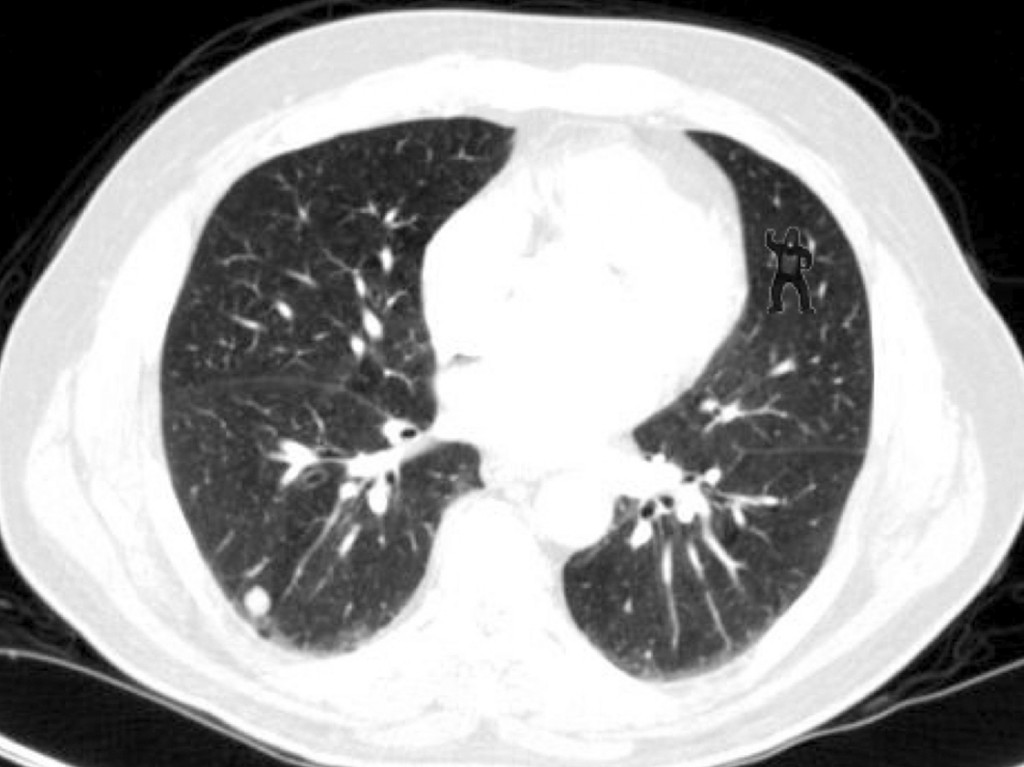Feb 12 2013
Gorilla in the Bronchi
Take a look at the picture just below the fold. Pretend you are a radiologist and your job is to find anything strange or abnormal on the scan. You are specifically looking for signs of cancer, but you need to find anything abnormal.
Done? OK – did you see the gorilla in the right upper corner of the scan? If you didn’t, don’t feel bad. Neither did 83% of radiologists studied, according to Trafton Drew who ran the study (which has not yet been published).
Readers of this and other skeptical blogs are likely familiar with this classic video of students tossing basketballs to each other (if not, take and look before reading further). About half of the people viewing this video miss the obvious gorilla strolling across the screen. This is a phenomenon known as inattentional blindness – when our attention is focused on a specific task we are likely to miss information that is extraneous to that task, even if it is in our visual field and otherwise obvious.
As an aside, when doing some further background research for this post I came across this blog post on The Invisible Gorilla, by Daniel Simons, the researcher who did the famous basketball-gorilla video experiment. He writes about two studies that were discussed in Mary Roach’s book, Spook. They were probably the first studies of inattentional blindness, published in the Journal of the Society for Psychical Research in 1959. They were only inadvertently about inattentional blindness, however.
The researcher was interested in ghost sightings, and so he donned a sheet and walked down a college campus in one study, and across a movie stage in another (while a trailer was playing). In the first case no one reported seeing anything unusual, and in the second only about half the audience noticed anything. The author concluded that “real” reports of ghost sightings must be different, that they must contain some psi component. What he really documented, however, was the first experiment to demonstrate inattentional blindness. The ghost fared about as well as the gorilla – 50% noticed something.
This whole business is more than just a fun parlor trick, however. This research has implications for everyday life, such as driving. Not seeing a pedestrian or motorcycle in your path can be the same as missing the gorilla, but with dire consequences. In the current study, radiologists interpreting a CT scan is, of course, of great importance. This is particularly interesting because Radiologists are trained to see everything on a scan.
I can see how radiologists would be an interesting group to study in follow up to the basic gorilla experiments. Radiologists are very consciously looking at the entire scan for anything unusual, but at the same time are looking for specific known abnormalities, such as evidence of cancer (the specific task given the radiologists in this study). Therefore they may be engaging in a deliberate combination of task-specific attention to catch the known but also broad attention to catch the unexpected.
This study suggests that most radiologists are engaging in the former more than the latter. This leads to many further questions and potential follow up studies: In this study the radiologists were told to look for signs of cancer, and they probably believed that was the point of the study, so the results may be partly an artifact of study design. I would like to see the same study but on a group of naive radiologists who don’t know they are being studied. (There may be some ethical problems with this kind of study, including consent but also perhaps unintended consequences on the real medical readings the subject radiologists are doing.)
Researchers can also study if differing instructions will alter the outcome – being told to find cancer vs being told to find anything abnormal. I would also like to see if there is any correlation, positive or negative, with finding the gorilla and the medical accuracy of the radiologists. Are radiologists who see the gorilla better or worse at also finding cancer? At the very least this research should have implications for training radiologists, and perhaps even suggest protocols to minimize missing pathology.
This is yet another example of the importance of understanding how our brains work, and specifically how they process information. Being naive about normal cognitive processing leads to unrecognized potential for error, and also to erroneous conclusions.
In the ghost studies above, the researcher, like many sincere believers in the paranormal, could not understand how people would miss something as obvious as a person wearing a white sheet walking down the sidewalk. This lead to a paranormal interpretation of the results. Now we understand this as a neurological phenomenon. The same is true of many phenomena that are interpreted as paranormal but are really just neuropsychological.







